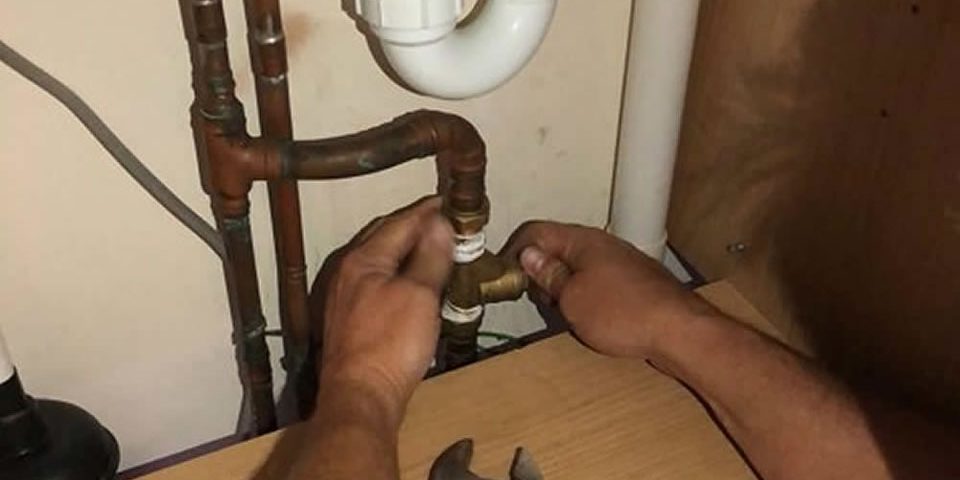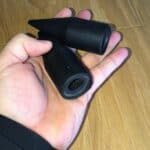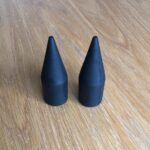4 Ways to isolate your water supply
If you’ve ever needed to isolate your water supply, you’ll know it’s not always easy to do. In fact, there are several ways you can turn your water off. Today, we’ll look at the four best ways to stop the water flow while you carry out repairs.
When you discover an issue with your plumbing, the first thing you need to do is isolate your water supply. Or, in other words, you need to stop the flow of water in the affected area.
Depending on the plumbing repair needed – whether it’s a water leak, a burst pipe, broken shower, leaking bath or toilet, or something else – some methods to isolate your water supply might vary.
Plumbing systems can also vary, so start by identifying which water supply you have.
Gravity or mains fed water supply?
You’re likely to have either a gravity-fed or mains-fed water supply – or possibly a combination of both.
For example, if you still have water tanks in your loft or cupboard, you might have gravity-fed hot water from the tank, while your cold water is direct from the mains.
The type you have can affect how you isolate your water supply – so that you can prevent water coming out of the tap while you fix it.
1. Isolate using service isolation valves
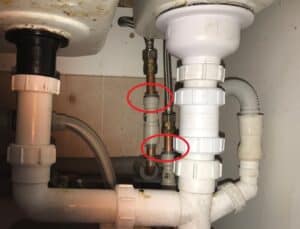
The isolation valves you’ll typically find behind a sink are marked here in red.
You can use this method to isolate your water supply with both a gravity and a mains-fed supply.
Locate the service isolation valves, which will be fitted in an accessible position directly below the terminal fittings of your taps. Simply use your flat head screwdriver to turn the slotted part of the isolation valve horizontal / perpendicular to the pipework.
Warning! These valves are prone to leaks due to age and quality of the fitting. If you are unsure how well they will isolate the supply, leave them alone and try option 2.
2. Stop the flow with bungs
This may seem hard to believe, but in most situations, this is my favourite way to isolate the supply to the tap you want to fix.
Firstly, prepare a safe access route to your cold water storage tank, usually in your loft. Then run the taps you want to fix.
Next, use a couple of tank bungs to plug the open vent pipe and cold water outlets to your cold water tank. Wait for the flow to stop on both of your hot and cold water taps, then you’re ready to begin your repair job.
- This is how big tank bungs are
- Some black tank bungs
I’d recommend buying these Regin water tank bungs.
Warning! If your hot water cylinder is gravity-fed, ensure you switch of the power to the pump before you run your basin taps dry. And remember to switch the power back on when you finish. If you had to drain your entire cold water tank, you’ll need to allow the water to flow back through before switching the electric back on. You don’t want to run the pump dry!
3. Isolate using your stop cock
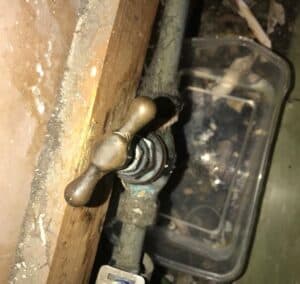
These older style 15mm stopcocks are quite common, especially in older buildings
This is my least favourite option, as it can cause a lot of other issues, included the dreaded air lock in your pipes.
Isolate your cold mains water supply by closing your internal or external stop cock – whichever one works and providing it doesn’t leak. Then run your basin taps. Once the water stops completely, you’re good to go with your repairs.
When you’ve finished your plumbing repairs, re-open your stop cock to allow the water to flow again. Hopefully, the air in the pipes will completely clear as your storage tank refills and water flows to your taps again.
If you manage this successfully without an air lock, I’d like to congratulate you and look forward to a drink with you if our paths ever cross!
4. Isolate mains-fed supply
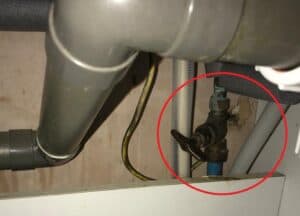
This is a mains-fed cold supply stopcock
I’ve saved the simplest way to isolate your water supply until last. But this only works if you’ve a mains-fed supply with an unvented cylinder or a combination boiler.
Quite simply, all you need to do is isolate the cold water mains supply under your kitchen sink or with your outside stop cock – whichever is easier to access.
Before you work on your taps, be sure to let off the pressure from your basin taps and any other taps you use to drain your system.
Then, when you’ve completed your repairs, close the basin taps before you turn your water supply back on. Gently re-open the taps, so you control the flow and clear any air in the system.
Bonus Tip – newer isolation valves
If you have a black plastic circular cover where your water meter is located, outside on the pavement, this indicates you have a newer isolation valve.
Your Water Board takes responsibility for fitting and maintaining these.
You’ll see a black tee piece key which slots into the water meter isolation slot. Turn the tee piece clockwise until it’s fully closed. Release the pressure from your kitchen sink taps to check it’s worked.
This is also useful to know if you have an uncontrollable leak and need to shut down your whole property’s water supply quickly.
If you live in Bracknell, Reading, Wokingham, Tilehurst, Sonning, Winnersh, Caversham or surrounding areas, we can help with any water supply isolation issues you’re having, along with any other emergency plumbing repairs.
Our quick response service means you will enjoy free-flowing hot and cold water for your showers and taps again in no time. Contact us now if you need our help.

